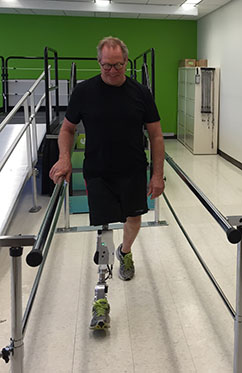


Posted July 17, 2015
Levi Hargrove, Ph.D., Rehabilitation Institute of Chicago
 Most commercially available prosthetic legs are passive, primarily providing basic structural support. Movement of a passive prosthetic joint relies on the properties of its mechanical components, and the movement is controlled by users through the coordination of their remaining intact muscles. Such requirements significantly limit the function of the prosthesis, especially for individuals with amputations at or above the knee. Mechanically powered prosthetic legs have recently become commercially available. The commercially available legs and several advanced prototypes are greatly improved compared to the passive versions. These amazing devices are equipped with sensors to provide information with regard to the state of the device (e.g., whether the person is bearing weight on the device, or swinging it in space). These sensors are used to control the prosthesis, but further improvements are required to take full advantage of the device's capabilities.
Most commercially available prosthetic legs are passive, primarily providing basic structural support. Movement of a passive prosthetic joint relies on the properties of its mechanical components, and the movement is controlled by users through the coordination of their remaining intact muscles. Such requirements significantly limit the function of the prosthesis, especially for individuals with amputations at or above the knee. Mechanically powered prosthetic legs have recently become commercially available. The commercially available legs and several advanced prototypes are greatly improved compared to the passive versions. These amazing devices are equipped with sensors to provide information with regard to the state of the device (e.g., whether the person is bearing weight on the device, or swinging it in space). These sensors are used to control the prosthesis, but further improvements are required to take full advantage of the device's capabilities.
Electromyographic (EMG) signals have been used for decades to control upper limb prostheses and several clinically viable systems have been developed. Properly decoded EMG signals provide data on how the person intends to use the device. For example, an individual's lower limb muscle activation patterns can indicate whether the person intends to walk or if they intend to climb stairs. Dr. Levi Hargrove of the Rehabilitation Institute of Chicago hypothesized that EMG signals in conjunction with data recorded from the mechanical sensors and temporal information associated with gait patterns would enable the creation of a control system that allows users to ambulate across a wide variety of terrains and seamlessly transition between different types of activities. To test his theory, Dr. Hargrove received a fiscal year 2008 award from the United States Army's Telemedicine and Advanced Technology Research Center, now part of the Congressionally Directed Medical Research Programs (CDMRP) to evaluate how much improvement could be gained by adding neural information to the control system.
The first phase of the project was an extensive engineering effort with collaborators at Vanderbilt University to allow advanced knee-ankle prostheses to accept neural inputs from the user. This new prosthetic device was tested on six patients with transfemoral amputations and one patient with a knee-disarticulation amputation in a randomized control trial. Electrodes were placed over the participant's residual limb thigh muscles to record EMG signals simultaneously with signals from integral mechanical sensors on the prosthesis. Two pattern recognition frameworks were tested. One used mechanical sensor signals only, and the other used mechanical sensor signals in combination with EMG signals and time history information from gait profiles. Participants were asked to ambulate throughout the lab without knowing which configuration was in operation. Dr. Hargrove found that including EMG signals and temporal information in the control system resulted in a significant reduction (p<0.05) in both overall perturbation error rates and errors that caused moderate perturbations (i.e., errors that were noticeable and slightly uncomfortable to the subject but did not cause them to stop ambulating or require use of the safety harness) to the patient. All participants could appreciate the difference between the two systems and preferred the system that included EMG signals and temporal information. Enhancements in utilizing EMG signals, pattern recognition, and training allowed additional participants to seamlessly move and transition between ambulation modes, including level-ground walking, incline walking, stair climbing, sitting, and standing.
The EMG-assisted powered prosthesis shows immense promise as a method to control the next generation of powered leg prostheses that are coming to market. With continued CDMRP support from a fiscal year 2013 award under the Joint Warfigher Medical Research Program, current research is incorporating an adaptive pattern recognition framework into powered leg prostheses, so the system maintains (or improves) robust performance with increased usage. The next steps in preparation are to perform a clinical trial with the assistance of partners at Vanderbilt University and Brooke Army Medical Center to evaluate performance improvements gained by users when they use powered devices in their home environment. The successful advancement of integrating neural information to control powered leg prostheses is an exciting step towards providing lower-limb amputees with effortless ambulation and improving the lives of prosthesis users.

Transfemoral amputee Terry Karpowicz is walking with the powered knee and ankle prosthesis. His residual limb muscle signals along with mechanical sensor signals embedded in the prosthesis enable ambulation and seamless transitions between different activities.
Publications:
Hargrove, LJ, Young AJ, Simon AM, et al. 2015. Intuitive control of a powered prosthetic leg during ambulation: A randomized clinical trial. JAMA 313(22):2244-2252.
Rouse E, Hargrove L, Perreault E, et al. 2014. Estimation of human ankle impedance during the stance phase of walking. IEEE Trans Neural Syst Rehabil Eng 22(4):870-878.
Gregg RD, Rouse EJ, Hargrove LJ, et al. 2014. Evidence for a time-invariant phase variable in human ankle control. PLoS One 9(2):e89163.
Young AJ, Simon AM, and Hargrove LJ. 2014. A training method for locomotion mode prediction using powered lower limb prostheses. IEEE Trans Neural Syst Rehabil Eng, 22(3):671-677.
Simon AM, Ingraham KA, Fey NP, et al. 2014. Configuring a Powered Knee and Ankle Prosthesis for Transfemoral Amputees within Five Specific Ambulation Modes. Plos One, 9(6):e99387.
Souza JM, Fey NP, Cheesborough JE, et al. 2014. Advances in transfemoral amputee rehabilitation: Early experience with targeted muscle reinnervation. Curr Surg Rep 2:51.
Rouse EJ, Hargrove LJ, Perreault EJ, et al. 2013. Development of a mechatronic platform and validation of methods for estimating ankle stiffness during the stance phase of walking. J Biomechan Eng 135(8):81009.
Hargrove LJ, Simon AM, Young AJ, et al. 2013. Robotic leg control with EMG decoding by an amputee with nerve transfers. N Engl J Med 369:1237-1242.
Young AJ, Simon AM, Fey NP, Hargrove LJ. 2013. Intent recognition in a powered lower limb prosthesis using time history information. Ann Biomed Eng 42(3):631-641.
Hargrove LJ, Simon AM, Lipschutz R, et al. 2013. Non-Weight-Bearing Control of a Powered Transfemoral Prosthesis. J Neuroengin Rehabil 10(1):62.

















